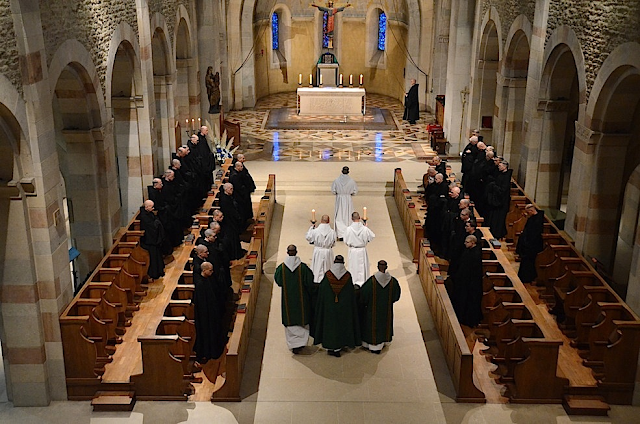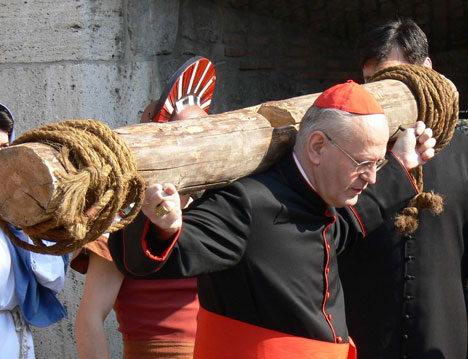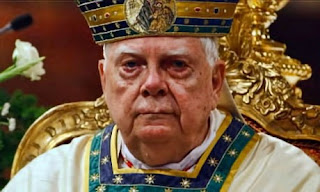Catholic devotions for 23rd June
Scroll down for today's
Saint of the Day/ Feast
Reading of the Martyrology
Dedication of the Month
Dedication of the Day
Rosary
Five Wounds Rosary in Latin
Seven Sorrows Rosary in English
Latin Monastic Office
Reading of the Rule of Saint Benedict
Celebration of Mass
Reading from the School of Jesus Crucified
Etheldreda was born in 679 to the King Anna of East Anglia near Newmarket in Suffolk. Not much is known about her early life until her first marriage in 652 to Tondberht, ealdorman of the South Gyrwas. While this was a short marriage ending in 655 Etheldreda claimed she remained a virgin during the entirety of the marriage. During her second marriage to While this isn’t unusual for a woman to remain a virgin after her marriage, it was unusual for a woman of royalty to remain a virgin after her marriage. Nevertheless, Etheldreda would marry for a second time to Ecgfirth, prince and future king of the Northumbrians. Even during this marriage Etheldreda still remained a virgin. The two would be married for twelve years, and during this time Etheldreda would be crowned Queen of NorthumbriansHowever, after these twelve years of marriage Ecgfirth could no longer agree to Etheldreda reaming a virgin. According to legend Ecgfirth would try and persuade Etheldreda to break her vow many times until he finally demanded that he sleep with her. Etheldred would then leave him with the aid of a bishop and join the royal monastery at Coldingham led by her aunt AEbbe.
Etheldreda would remain in Coldingham for a year, then she would return to East Angel and establish the Ely Cathedral. Her church would be categized as a double monastery meaning, both men and women were permitted to live together under the guidance of an abbess. The abbey was soon flourishing and would be marked as one of the richest abbeys in England for this time
During this time Etheldreda would develop a tumor-like growth on her neck. Etheldreda wrote that this tumor was actually a punishment from God for her vanity during her youth. She wrote “when I was a young girl I used to wear an unnecessary weight of necklaces; I believe that God in His goodness would have me endure this pain in my neck in order that I may thus be absolved from the guilt of my needless vanity”
The Reading from the Martyrology
This Day, the Twenty Third Day of June
The vigil of St. John the Baptist.
At Rome, in the reign of Julian the Apostate, St. John, a priest, who was decapitated on the old Salarian road, before an idol of the sun. His body was buried near those of other martyrs by the blessed priest Concordius.
Also, at Borne, St. Agrippina, virgin and martyr, under the emperor Valerian. Her body was carried to Sicily, where it works many miracles.
At Sutri, in Tuscany, St. Felix, priest. By the command of the prefect Turcius, he was struck on the mouth with a stone until he breathed his last.
At Nicomedia, in the time of Diocletian, the commemoration of many holy martyrs, who concealed themselves in mountains and caverns, and joyfully underwent martyrdom for the name of Christ.
At Philadelphia, in Arabia, the holy martyrs Zeno, and Zenas, his slave. When the latter kissed the chains of his master, begging to be his partner in torments, he was arrested by the soldiers, and received the crown of martyrdom with him.
In England, St. Audry, queen and virgin, who departed for Heaven with a great renown for sanctity and miracles. Her body was found without corruption eleven years afterwards.
At Turin, St. Joseph Cafasso, priest, renowned for his piety and learning, and for his work with prisoners, reconciling to God those who were preparing for execution. He was added to the number of the Saints by Pope Pius XII.
In England, in the monastery of Ely, St. Etheldreda, queen and virgin, who departed for Heaven with a great renown for sanctity and miracles. Her body was found without corruption eleven years afterwards.
And elsewhere in divers places, many other holy martyrs, confessors, and holy virgins.
Omnes sancti Mártyres, oráte pro nobis.
("All ye Holy Martyrs, pray for us", from the Litaniae Sanctorum, the Litany of the Saints)
June is the Month of the Sacred Heart
Amen.
V. Heart of Jesus once in agony.
R. Pity the dying.
(300 days every time said. Plenary indulgence under the usual conditions if said thrice daily'but at three distinct times during the day'for a month)
(a) V. Praised be Jesus Christ.
R. Amen'or'Forever.
(b) V. Praised be Jesus and Mary.
R. Today and forever.
(c) V. Glory to the Sacred Heart of Jesus.
R. Glory to the immaculate heart of Mary.
(300 days every time any one of the foregoing is said as salutation and answer)*
Graciously grant, O Lord, peace in our times, that, aided by the help of Thy mercy, we may always be free from sin and secure from all disturbance. Through Christ Our Lord. Amen.
(3 years every time said)*
Burn, O Lord, our loins and our hearts with the fire of the Holy Ghost, that we may serve Thee with a chaste body and please Thee with a pure heart. Through Christ Our Lord. Amen.
(3 years every time said)*
Prayers for Every Day of the Week
The Joyful Mysteries of the Rosary are prayed on Monday
"I would like to remind you that the Rosary is a biblical prayer, all filled with the Holy Scriptures." It is a prayer from the heart, in which the repetition of the Ave Maria directs the thought and affection towards Christ, and thus is made a confident prayer to Him and our Mother. It is a prayer that helps to meditate on the Word of God and assimilate the Eucharistic Communion, on the model of Mary who kept in her heart everything Jesus did and said and even His Presence. " Pope Benedict XVI
The Rosary in Latin
Chaplet of the Five Holy Wounds of Christ in Latin
Chaplet of the Seven Sorrows of Our Lady in English
Latin Monastic Office for today from Le Barroux in France Texts also provided
The Reading of the Rule of Saint Benedict for June 23
XVIII QUO ORDINE IPSI PSALMI DICENDI SUNT
7 Ad tertiam vero, sextam nonamque secundae feriae, novem capitula quae residua sunt de centesimo octavo decimo, ipsa terna per easdem horas dicantur.
8 Expenso ergo psalmo centesimo octavo decimo duobus diebus, id est dominico et secunda feria,
9 tertia feria iam ad tertiam, sextam vel nonam psallantur terni psalmi a centesimo nono decimo usque centesimo vicesimo septimo, id est psalmi novem.
10 Quique psalmi semper usque dominica per easdem horas itidem repetantur, hymnorum nihilominus, lectionum vel versuum dispositionem uniformem cunctis diebus servatam.
11 Et ita scilicet semper dominica a centesimo octavo decimo incipietur.
CHAPTER 18: IN WHAT ORDER THE PSALMS ARE TO BE SAID
7 At Terce, Sext and None on Monday are said the nine remaining sections of Psalm 118, three parts to be said at each hour.
8 Thus having completed Psalm 118 in two days (that is Sunday and Monday),
9 on Tuesday at Terce, Sext and None three psalms each are chanted from Psalm 119 through 127, that is from nine psalms.
10 These psalms are always repeated until Sunday at the same hours every day: the disposition of hymns, lessons and versicles remains uniform on these days.
11 And so in this way Psalm 118 is always to begin on Sunday.
Today's Celebration of the Mass
In Bologna, in the Basilica of Santa Maria dei Servi, this painting by Jacopo Alessandro Calvi known as Sordino, depicts the four Servite fathers Tommaso Corsini (whose feast today), Gerolamo Ranuzzi, Piriteo Malvezzi and Francesco Patrizi all in adoration of the Trinity appearing high up on clouds.
also today
Jesus XPI Passio sit semper in cordibus nostris

.jpg)













.jpeg)

Comments